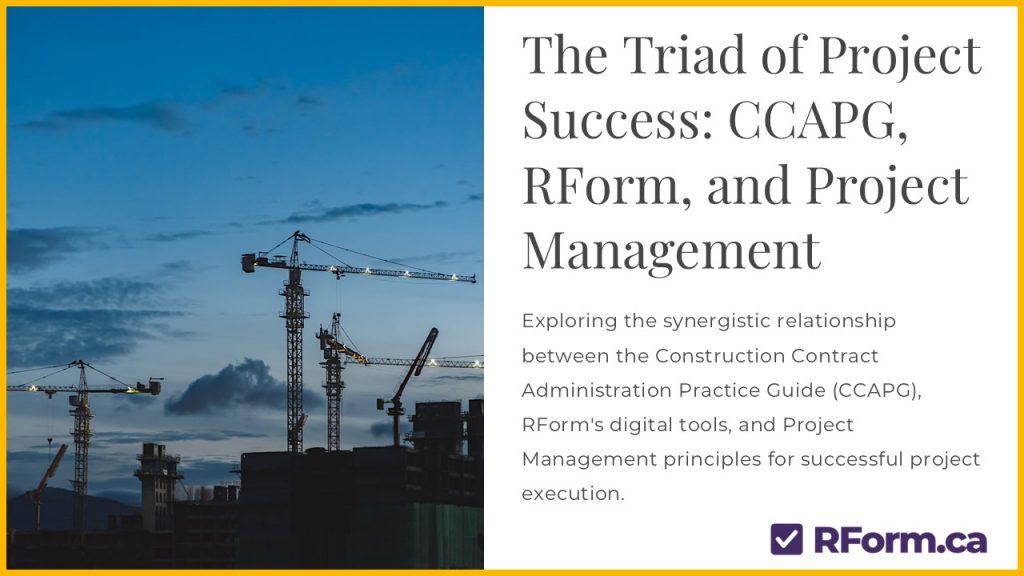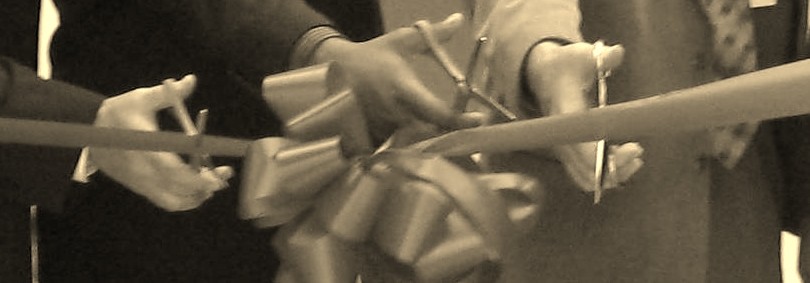
The Construction Contract Administration Practice Guide (CCAPG), RForm’s features, and Project Management methodologies provide a comprehensive solution for successful project execution. The CCAPG lays the foundation by defining the roles, responsibilities, and best practices for contract administration. At the same time, RForm offers digital tools to implement these practices, and Project Management provides the overarching framework to guide the entire process.
How they complement each other:
- CCAPG as the Knowledge Base: The CCAPG acts as the theoretical backbone, providing detailed guidance on contract documents, submittals, payments, claims, and project closeout. It outlines the ‘why’ and ‘how’ of contract administration, offering a framework for understanding the complexities of the construction process.
- RForm as the Digital Toolbox: RForm’s features translate the CCAPG’s theoretical knowledge into practical, actionable tools. It digitizes and streamlines key contract administration processes, such as submittal tracking, RFI management, change order handling, and document control. This allows for real-time collaboration, improved communication, and efficient information management.
- Project Management as the Guiding Force: Project Management principles and methodologies provide the overall structure and direction for the project. It encompasses planning, scheduling, resource allocation, risk management, and communication strategies, ensuring the project is executed efficiently and effectively. RForm’s features support project management by providing tools for tracking progress, managing resources, and identifying potential risks.
Together, they offer a complete solution:
- Enhancing Communication and Collaboration: RForm facilitates real-time communication and information sharing among project stakeholders, promoting transparency and enabling quick decision-making. This aligns with the CCAPG’s emphasis on effective communication and collaboration for successful contract administration.
- Streamlining Processes and Improving Efficiency: RForm’s digital tools automate and streamline key contract administration tasks, reducing paperwork, minimizing errors, and saving time. This allows project teams to focus on core activities and achieve project goals more efficiently, as project management principles advocate.
- Mitigating Risks and Disputes: By providing a clear and transparent platform for managing contracts, submittals, changes, and payments, RForm helps to minimize misunderstandings and conflicts, reducing the potential for claims and disputes. This aligns with the CCAPG’s focus on risk mitigation and dispute avoidance.
- Ensuring Compliance and Quality: RForm’s features for tracking submittals, RFIs, and inspections support quality assurance and quality control efforts, ensuring that the project is executed in accordance with contract requirements and quality standards. This reflects the CCAPG’s emphasis on quality management throughout the project lifecycle.
Delving further into the differences between Construction Project Management and Contract Administration Software will highlight each software type’s distinct focus and functionalities and how they may not fully overlap.
Core Focus
- Construction Project Management Software: Primarily focuses on planning, scheduling, resource allocation, and cost control of the physical construction activities. It helps manage the execution of the project plan.
- Contract Administration Software: Focuses on managing the contractual and legal aspects of the project, including document control, submittals, RFIs, change orders, and payments. It ensures compliance with the contract terms.
Functionalities
- Construction Project Management Software: Offers features like Gantt charts, critical path method (CPM) scheduling, resource management, cost tracking, and progress monitoring. These tools are essential for managing the construction process itself.
- Contract Administration Software: Provides features like document management, submittal tracking, RFI management, change order processing, and payment certification. These tools are crucial for managing the contractual obligations and relationships between the parties involved.
Gaps and Overlaps
While functionalities such as document management and schedule tracking might overlap, the depth and specificity of these features may differ between the two software types. Construction Project Management Software might offer basic document storage and schedule tracking. Still, it may not have the advanced features required for comprehensive contract administration, such as submittal workflows, RFI routing, and change order tracking.
The CCAPG emphasizes the importance of meticulous documentation, communication, and compliance in contract administration. It highlights the need for tools to manage complex processes like submittals and RFIs. These processes often involve multiple stakeholders and require careful tracking and documentation to ensure that contractual obligations are met and potential disputes are minimized. Construction Project Management Software may not offer the specialized features to manage these processes effectively.
While Construction Project Management Software is invaluable for managing physical construction activities, it may not fully address the specific needs of contract administration. Contract Administration Software, with its focus on document control, communication, and compliance, is essential for effectively managing the contractual and legal aspects of the project.
The Triad of Project Success: CCAPG, RForm, and Project Management
- CCAPG: The Blueprint – The CCAPG acts as the guiding document, establishing the rules and best practices for contract administration. It’s akin to the architectural plans for a building, providing the theoretical framework and knowledge base.
- RForm: The Digital Enabler – RForm’s features digitize and automate many of the processes outlined in the CCAPG. It’s like the construction tools and machinery that bring the blueprint to life. Features like submittal tracking, RFIs, and change order management facilitate efficient communication and documentation, which is crucial for successful contract administration.
- Project Management: The Orchestrator – Project Management provides the overarching strategy and coordination to ensure all the moving parts work together harmoniously. It’s the project manager’s role to oversee the entire process, from planning and scheduling to risk management and communication. RForm’s features, such as a schedule of values and site reports, provide valuable data for project managers to make informed decisions and keep the project on track.
The three elements work in tandem to provide a complete solution for achieving project outcomes:
- Clarity and Compliance: The CCAPG sets the standards, RForm provides the tools to adhere to those standards, and Project Management ensures that the processes are followed, leading to greater clarity and compliance in contract administration.
- Efficiency and Collaboration: RForm’s digital platform streamlines communication and documentation, fostering stakeholder collaboration. This enables project managers to make informed decisions and keep the project moving forward efficiently.
- Risk Mitigation and Dispute Avoidance: By promoting transparency and facilitating timely resolution of issues, RForm, guided by the CCAPG and project management principles, helps to mitigate risks and avoid costly disputes.
- Data-Driven Decision Making: RForm’s features, such as a schedule of values and site reports, provide valuable data for project managers to track progress, manage resources, and identify potential risks, enabling data-driven decision-making.
In conclusion, the CCAPG, RForm, and Project Management form a powerful triad. The CCAPG provides the knowledge, RForm provides the digital tools, and Project Management provides the strategic oversight, ensuring that projects are executed successfully and meet the needs of all stakeholders.
Reference:

